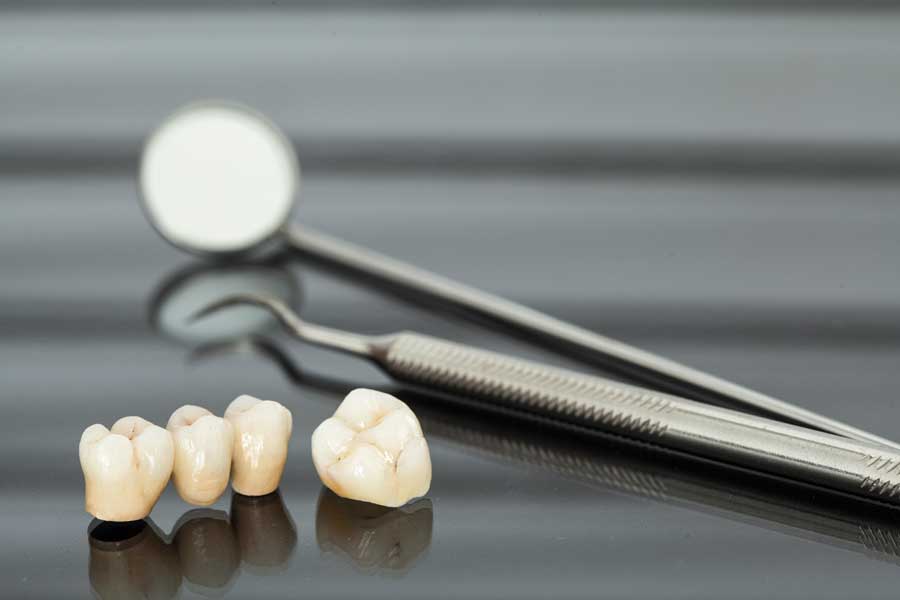
Dental Bridges
Do you have some missing teeth that you’d like to replace? Do you want to enhance the quality of your smile with a full set of pearly white teeth? If so, dental bridges are some of the best option for you.
In addition to simply enhancing your aesthetic appeal and bridging the gap between your teeth, they can also help you chew and speak better. Please continue reading for a detailed discussion of what is a dental bridge and the dental bridge procedure.
What is a Dental Bridge?
A dental bridge is a set of prosthetic or fake teeth (called pontics) used to bridge the gap left by missing teeth. It is a set of teeth surrounded by dental crowns on either side to hold the bridge in place. The primary purpose of a dental bridge is to replace missing teeth.

What are the Pros and Cons of Dental Crowns versus Bridge?
It’s hard to describe the pros and cons of dental crowns versus bridges because they often go hand-in-hand. Dental crowns are often necessary to support the dental bridge and hold them in place.
Difference between Dental Crowns and Dental Bridges
- Dental crowns are used to cover up broken, misaligned, or stained teeth. Dental bridges don’t cover up but rather replace missing teeth.
- In order to place dental crowns, the dentist needs to alter the original tooth and remove its outer shell. However, since dental bridges are placed over missing teeth, there’s no alteration necessary.
- Dental crowns can be placed in isolation on an individual tooth. Dental bridges, however, need to be supported either by dental crowns or dental implants.
Pros of Dental Bridges
The following are some of the primary advantages of dental bridges:
- Giving you a complete smile makeover.
- Allowing you to chew and speak properly again by replacing the missing teeth.
- Maintaining the shape of your face.
- Preventing the surrounding teeth from drifting away because of the gaps.
- Distributing the force of your bite.
Cons of Dental Bridges
They have to be supported by dental crowns or dental implants. If you get dental crowns, then the surrounding teeth will have to be altered to fit the crown.
Schedule a Porcelain Crowns Appointment
Types of one of the Best Dental Bridges
Depending on the type of support structure, there are four primary types of dental bridges — traditional dental bridges, cantilever dental bridges, maryland dental bridges, and implant-supported dental bridges.
Traditional Dental Bridges
These are the most common types of dental bridges. In this case, there are one or more pontics to replace the missing teeth and they’re anchored by dental crowns on both sides. The dentist has to remove the outer shells of the surrounding teeth so that dental crowns can be filled over them to support the dental bridge. As such, traditional dental bridges are completely permanent in nature because the removed enamel will never grow back and the anchoring teeth will always need dental crowns.
Cantilever Dental Bridges
In this case, you have one or more pontics and they’re supported by a dental crown on only one side. The tooth next to the missing teeth will be shaved and reduced so the dental crown can be placed over it and the dental bridge can be secured. This procedure is also permanent because the anchoring tooth will always need dental crowns.
Maryland Dental Bridges
Maryland dental bridges are a good option for those who don’t want to alter the original structure of their surrounding teeth, making it a reversible procedure. In this case, the pontics will have to be secured by metallic or porcelain abutments. In this case, the dental bridge will be weaker because the prosthetic abutments may be weak and the framework may also get in between the gums. Maryland dental bridges aren’t generally used in areas of high impact — like molars — because they’re weaker.
Implant-Supported Dental Bridges
Dental implants are the strongest and most natural way of replacing missing teeth. In this case, a metal framework or post is drilled into the jawbone of the missing socket. If you’re missing several teeth, then several implants will have to be attached. The dental bridge will then simply be placed over the implant posts. The resultant teeth will be extremely strong and they’ll look and feel like real teeth. This whole procedure may take several weeks as the dentist will have to prepare your mouth to accept the dental implants, then place the posts, allow some recovery time, then design the dental bridge and place them.
Dental Bridge Procedure
The dental bridge procedure may take several sessions and the exact steps of the process depends on the type of dental bridge. The following is an overview of the dental bridge procedure if you’re getting traditional or cantilever dental bridges:
- The dentist first examines your teeth to determine which type of dental bridge is most suitable for your teeth. They’ll discuss all of your options with you. The dentist will also take impressions of your teeth on a dental mold and record the exact shade of your teeth.
- If you decide to proceed with traditional or cantilever dental bridges, then the dentist will first prepare your anchoring teeth by removing the enamel and outer shell.
- The dentist will send your dental mold to prepare the dental bridge. This procedure may take over 2 weeks. In the meantime, the dentist will place temporary dental crowns on the shaved teeth.
- Once the dental bridge is prepared, your dentist will remove the temporary crowns and attach the permanent dental bridge in place. They’ll make some final adjustments and polish the teeth so they perfectly resemble your other teeth.
- After a few weeks, the dentist will cement the dental bridge permanently if they determine that the existing set is a perfect fit.
Dental Bridge or Dental Implant. Which is the Best for Me?
If you want to restore a completely natural smile with a set of teeth that’s indistinguishable from your real teeth, dental implants are one of the best option. Dental implants are attached firmly to your bone structure and they become a part of your teeth, which is why they act like and resemble real teeth. Dental bridges, in comparison, may be a little visible when you smile. However, you can also get implant-supported dental bridges, which marries the best of both worlds.
Schedule your Tooth Bridge Appointment
At URBN Dental Uptown , we thoroughly examine your teeth and discuss your expectations. We offer all of the different types of dental bridge options — traditional, cantilever, maryland, and implant-supported. We also provide dental bridges in various material types. Once you come for your appointment, our dentist will discuss your dental bridge options and proceed with the treatment. For more information, please schedule your tooth bridge appointment immediately.
